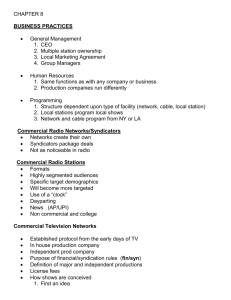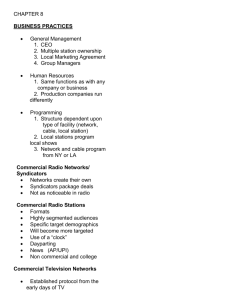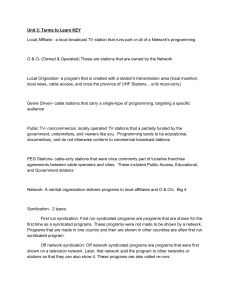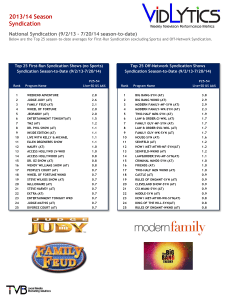Radio 13 - Pegasus @ UCF
advertisement
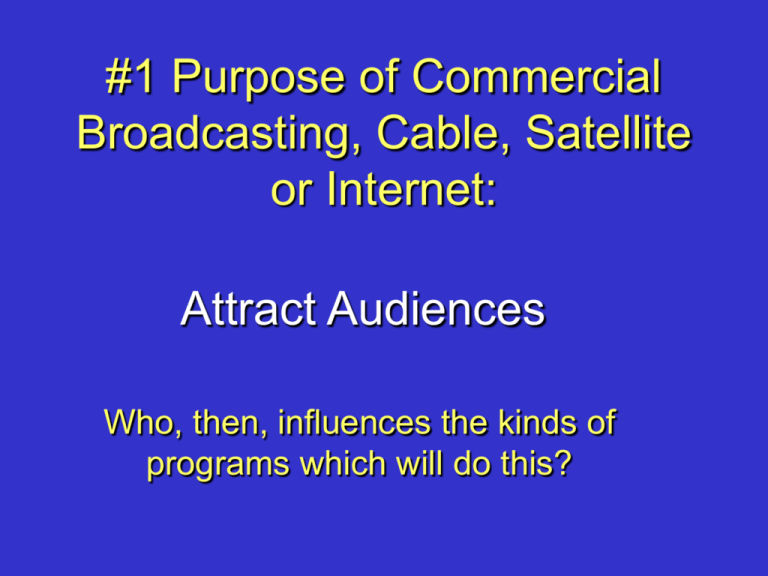
#1 Purpose of Commercial Broadcasting, Cable, Satellite or Internet: Attract Audiences Who, then, influences the kinds of programs which will do this? Advertisers Set the Trend • • • • Narrowcasting Demographics Psychographics Segmentation Programs follow the trend Consumer Targets • Males and females 18-34 • Females 25-54 • Marketing studies indicate they wield the most spending power • They may also have the most disposable income Bottom Line Thinking: • Programmers want the best shows for the best price • The aim is to get the most valuable viewers for the least cost • All other considerations secondary • What does that say about us? Programs and Cost Parsimony Principle • Sparing use of material (stretching plot) • Replay (summer reruns, scheduled reruns) • Repurposing (Network shows appear on cable channels owned by the same media corporation) • What is lost/what is gained Birth of a Program • Network tells studios what audience it wants to target (studios already know) • Studios pull concepts off the shelf, make a pilot, show it to the Net • Net may like it, ask for changes, or ask for a few episodes • Only 25% make it on the air • Darwinian, market based and dumb Deficit Financing • Studios retain rights to the program and to its distribution • First purchase by Net rarely covers production costs • Resale to cable and individual TV stations is called off-network syndication • That’s where the REAL money is. • Are we getting the market point? Syndication Any non-local programs not currently licensed to a network • Off-network: have appeared or may still be running on a broadcast network • First-run: originally designed for syndication never seen on a network • How do new creative enterprises get in How Syndication Works • Industry showcases new offerings (but most deals happen before hand) • Station leases a syndicated program for a certain # of runs or a time period • Lease fee is cash or barter (free time) or a combination of both • Some contracts specify a time slot The Barter Dilemma: Trading advertising for programming • Progams come off the satellite with spots already inserted • Reduces # of local availabilities [avails] • Stations may also be forced to pay cash • Smaller markets/lower rated stations pay more--spots are less valuable Who’s doing the Syndicating? • Studios like Paramount and Buena Vista (with off-network syndication they can make a profit) • Production Companies like King World (their programs cheaper to produce) • Syndicators may bundle a genre together and offer packages of same • Local broadcast stations may pay extra for exclusivity on a given program Rules and Regs • fin/syn: elimination of this rule allowed the mergers of networks with production companies and syndication firms • (Financial Interest and Synication Rules) • Huge debates about access related to fin/syn rules. • The networks have freer reign again Radio Syndciation • • • • • • • Syndicated formats Syndicated features Talk show, business, consumer advise A growth in niche programming A shrinking diversity Less local content Much less jobs available Radio: Syndicated Formats Playlists are downlinked via Satellite Radio: Syndicated Features Rush Limbaugh Howard Stern DividingTV Dayparts • • • • • • • • • Early Morning (News and Info) Morning (Talk and Info) Noon (News) Afternoon (Soaps) Early Fringe/News Block (varies) Local Access Prime Time Late Fringe/News Block Late Night….. Overnight Radio Dayparts • • • • • • Morning Drive Midday Afternoon Drive Night Overnight Radio Format Clock p. 235: we will discuss March 20 TV Program Sources • • • • Local Major Hollywood Film Studios A few Minor Hollywood Studios A few Major/Minor Independent Producers • Some foreign syndicators Feature Films • 1st reach audience through theatres • More money made through video distribution • More money made through premium cable movie channels (HBO) • Even more money made through rights to broadcast networks • More money still… reruns on cable networks (Turner) Network Programming Strategies • • • • • • • Counterprogramming Block programming Stripping Strong lead-in Leading-out Hot switching Hammock Radio Program Strategies • Schedule program elements in 60 minute cycles (CNN was the first TV network to utilize this strategy) • Try to match audience activities and environments • Counterprogramming, stripping, blocking Program Promotion • Image: promote a station’s or network’s news philosophy or experience • Topical: promote specific news segments or entertainment episodes • Program: Generic • Billboard: lineup of what’s on tonight • Radio/TV “tradeouts” (may involve tickets)
